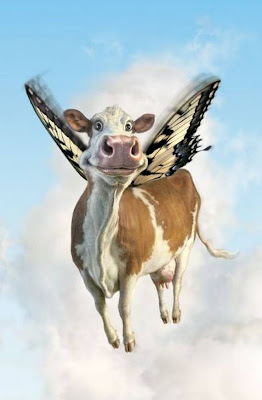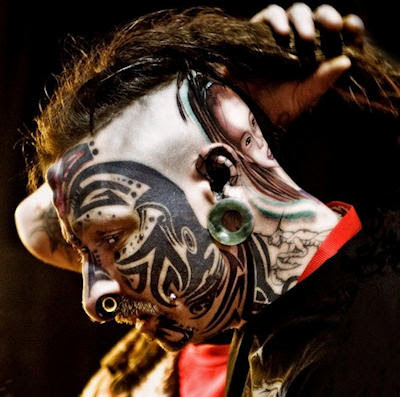





Source






Posted by
PostingMachine
at
2:02 AM
![]()
 Russian legends tell of a breed of homonids who were excellent herders, tough as (the yet to be invented) nails and most importantly made a sport of fighting Griffins for caches of gold.
Russian legends tell of a breed of homonids who were excellent herders, tough as (the yet to be invented) nails and most importantly made a sport of fighting Griffins for caches of gold.
It now appears that we have biological proof of these legendary wild men.
Siberia’s Denisova cave held the pinky bone of an unknown early human species, a genetics team reported in March. The Naturejournal study, led by Johannes Krause of Germany’s Max Planck Institute for Evolutionary Anthropology, offered no answer for what happened to this “archaic” human species, more than one million years old and living near their human and Neanderthal cousins as recently as 30,000 years ago.
But at least one scholar has an intriguing answer: “The discovery of material evidence of a distinct hominin (human) lineage in Central Asia as recently as 30,000 years ago does not come as a surprise to those who have looked at the historical and anecdotal evidence of ‘wild people’ inhabiting the region,” wrote folklorist Michael Heaney of the United Kingdom’s Bodleian Library Oxford, in a letter to The Times of London.
So it’s just a matter of finding some Griffin bones. But now that we have a pinky bone of a wild man, we just have to look for the foot he buried in the winged lion’s butt.
Posted by
PostingMachine
at
4:03 AM
![]()
The earliest forms of illustration were prehistoric cave paintings. Before the invention of the printing press, books were hand-illustrated. Illustration has been used in China and Japan since the 8th century, traditionally by creating woodcuts to accompany writing.[citation needed]
[edit] 15th century through 18th century
During the 15th century, books illustrated with woodcut illustrations became available. The main processes used for reproduction of illustrations during the 16th and 17th centuries were engraving and etching. At the end of the 18th century, lithography allowed even better illustrations to be reproduced. The most notable illustrator of this epoch was William Blake who rendered his illustrations in the medium of relief etching.
Illustration by Santiago Martinez Delgado. Early to mid 19th century
Notable figures of the early century were John Leech, George Cruikshank, Dickens’ illustrator Hablot Knight Browne and, in France, Honoré Daumier. The same illustrators would contribute to satirical and straight-fiction magazines, but in both cases the demand was for character-drawing which encapsulated or caricatured social types and classes.
The British humorous magazine Punch, which was founded in 1841 riding on the earlier success of Cruikshank’s Comic Almanac (1827-1840), employed an uninterrupted run of high-quality comic illustrators, including Sir John Tenniel, the Dalziel Brothers and Georges du Maurier, into the 20th century. It chronicles the gradual shift in popular illustration from reliance on caricature to sophisticated topical observations. These artists all trained as conventional fine-artists, but achieved their reputations primarily as illustrators. Punch and similar magazines such as the Parisian Le Voleur realised that good illustrations sold as many copies as written content.







Posted by
PostingMachine
at
4:55 AM
![]()
 New archeological evidence proves that the China’s Western Zhou dynasty dabbled in human sacrifice roughly 2,700 years ago.
New archeological evidence proves that the China’s Western Zhou dynasty dabbled in human sacrifice roughly 2,700 years ago.
“In general, there’s been a tendency to describe Western Zhou as a more humanistic period, when the practice of human sacrifices”—which were commonplace during the preceding Shang Dynasty—”were waning,” Sena said.
“But I think the archaeological evidence shows quite clearly that human sacrifices persisted throughout the Zhou period as well.”
So now we know.
Posted by
PostingMachine
at
3:55 AM
![]()

I have seen some freaky tattoos and body piercings in my time, but this guy really does look like a freak. How could anyone be able to walk down the street when you know that people will be staring at you.
Posted by
PostingMachine
at
2:11 PM
![]()

Check out this cool looking truck with one of the most unique decals I have ever seen. Plumbers are always being called out to fix somebody’s toilet so what better way to let people know that having this great decal on the side.
Posted by
PostingMachine
at
4:44 AM
![]()

For those of you who have been waiting for the news of the new Spider-Man 4 movie, we have the first exclusive pictures from the film. Now is it me or has Spidey put on a little bit of weight since the last movie.
Source
Posted by
PostingMachine
at
2:06 AM
![]()




Posted by
PostingMachine
at
2:03 AM
![]()
 I know this is an illness and yes I have put it under the weird category, the reason for this is because the human body takes so much shit when you think about it, so many illnesses, so many diseases, I mean come on where do these weird illnesses come from. Proteus syndrome is a congenital disorder that causes skin overgrowth and atypical bone development, often accompanied by tumours over half the body. Since Dr. Michael Cohen identified it in 1979, [1] only a few more than 200 cases have been confirmed worldwide, with estimates that about 120 people are currently alive with the condition.[2] There may be many more than this, but those individuals correctly diagnosed usually have the most obvious manifestations of Proteus syndrome, leaving them severely disfigured. Proteus syndrome is named after the Greek sea-god Proteus, who could change his shape.
I know this is an illness and yes I have put it under the weird category, the reason for this is because the human body takes so much shit when you think about it, so many illnesses, so many diseases, I mean come on where do these weird illnesses come from. Proteus syndrome is a congenital disorder that causes skin overgrowth and atypical bone development, often accompanied by tumours over half the body. Since Dr. Michael Cohen identified it in 1979, [1] only a few more than 200 cases have been confirmed worldwide, with estimates that about 120 people are currently alive with the condition.[2] There may be many more than this, but those individuals correctly diagnosed usually have the most obvious manifestations of Proteus syndrome, leaving them severely disfigured. Proteus syndrome is named after the Greek sea-god Proteus, who could change his shape.
There was a program about the boy with frozen bones which shows nine year-old Jordan who is full of hope and vitality. But Jordan’s body is not ordinary. He was born with a rare genetic condition called Proteus Syndrome, the same condition that afflicted John Merrick, The Elephant Man.
Posted by
PostingMachine
at
9:48 PM
![]()
Copyright 2010 - Humor Planet